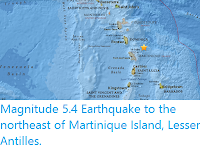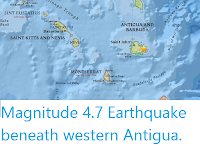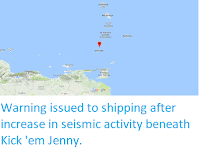The Granadan National Disaster Management Agency has raised the alert level around Kick 'em Jenny, a submarine volcano about 8 km to the north of Granada, following an abrupt rise in seismic activity in the area. A total of 1384 Earthquakes with a Magnitude greater than 1.0 were recorded in the week 5-12 June 2020, compared to only 29 in the whole of April and May. Such tremors are often caused by the movement of hot water
and volcanic gas beneath a volcano, which could indicate that the volcano is about to
erupt. As a precaution a shipping exclusion zone surrounds the Kick 'em Jenny to a
distance of 1.5 km; this zone has been increased to 5 km until further
notice, due to the heightened risk to shipping during
periods of activity.
Map showing the exclusion zone around Kick 'em Jenny. Caribbean 360.
Kick 'em Jenny rises 1300 m above the surrounding seafoor, but remains
180 m below the surface. It was first discovered in July 1939, when an
eruption broke the surface and threw material several hundred meters
into the air, as well as generating a tsunami which was observed as far
away as Barbados, though it was too small to cause any damage. However
Kick 'em Jenny is labled on many earlier maritime charts, indiating that
people have been aware there was something here for several centuries,
even if they did not know the nature of the feature.
5 m lateral resolution digital terrain model of the Kick ‘em Jenny current edifice. Robertson et al. (2015).
The
Lesser Antilles are located at the eastern fringe of the Caribbean
Tectonic Plate. The Atlantic Plate (strictly speaking, an extension of
the South American Plate which runs to the northeast of the Caribbean)
is being subducted beneath this, and
as it sinks into the Earth, is melted by the heat of the planets
interior. Some of the melted material then rises up through the
overlying Caribbean Plate as magma, fuelling Kick 'em Jenny and the other volcanoes of the Lesser
Antilles Volcanic Arc. The subduction of the Atlantic Plate beneath the
Caribbean Plate is not a smooth process, with the two plates constantly
sticking together then breaking apart as the tectonic pressure builds
up, causing Earthquakes in the process, though since the boundary
between the two plates is some way to the east of the islands,
Earthquakes in the Lesser Antilles tend to be both deep and offshore,
which lessens their destructive potential.
The subduction of the Atlantic Plate beneath the Caribbean Plate fuels the volcanoes of the Lesser Antilles Volcanic Arc. George Pararas-Carayannis.
See also...
Follow Sciency Thoughts on Facebook.









